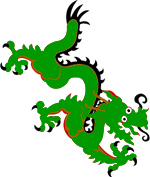|
|
 |
|
| |
 |
 |
|
|
An early Review:
The Nutritional and Therapeutic Value of Tea (J
Sci Food Agric, 26, 1975)
stated that: “The pharmacological action of green tea caffeine (lower than regular tea) is so modified by the interaction with the polyphenols that the beneficial properties of the alkaloid (vasodilator, anti-atherosclerotic, diuretic, fluid balance restoration following vomiting or diarrhoea, assisting recovery of mental depression [the cup that cheers] by providing alertness without loss of tranquility, stimulation of mental alacrity, relief of mental and muscular fatigue, enhancement of liver-metabolism and gastro-intestinal secretion, aiding digestion and relieving post-prandial distress and gout as well as promoting circulation and improving bronchial asthma and cardiac oedema), may be enjoyed without harmful side-effects.” “Green tea has been found to normalize the thyroid hyperfunction that causes thyroxicosis and also to afford protection against the development of leukaemia after exposure to radiation, as well as to eliminate radioactive strontium from the body before it reaches the bone marrow and causes long term radiation damage, and furthermore exerts an anti-inflammatory role beneficial in reducing the secondary effects of radiation damage to tissue. Green tea has been used extensively in combating plague and as an adjunct in the treatment of several diseases, including dysentery, typhoid and cholera. It is clear that it is much more than a pleasant, mildly stimulating beverage and warrants a thorough medical reappraisal.” More recently a published paper, The Biological Activity And Toxicological Test Of Tea Polyphenols (Proc Intl Symp Tea Sci, Shizuoka, Japan, Aug. 1991) stated: “From ancient times, tea is regarded as a healthy beverage. ‘Lost Property Of Medicinal Herbs’, an ancient book in China’s Chang Dynasty recorded that while various medicines are the cure of different diseases, ‘green tea is the cure to all’. There are active hydroxyl hydrogens in the molecular structure of green tea polyphenols that can end the chain reaction of excessive free radicals that (otherwise) result in pathological changes in the human body. Tea polyphenols can increase the activity of glutathione peroxidase and superoxide dismutase and the scavenging rate is much stronger than vitamins C and E. They are ideal anti-oxidants. The anti-carcinogenic mechanism includes both cellular immune function and the inhibition of tumor growth.” Noting the mounting evidence, another researcher added: “antidepressant, protection against sunburn and protection against nitrosamines”, and showing that tea is rich in potassium, zinc, manganese and copper, commented: “We must point out that tea is the most popular beverage after water and that its excellent reputation is justified”. (Lunder T, In ‘Phenolic Compounds in Food & Their Effects on Health’, [Symp] Amer Chem Soc, 1992) There is a positive correlation between green tea production (use) and average human life span. How do other health teas shape-up? In the only comparative study I have seen, researchers at the School of Food and Nutritional Sciences, University of Shizuoka, compared green tea, black tea and rooibos tea (a South African bush tea) on several parameters, but in particular, the potential to suppress the formation of advanced glycosylation endproducts (AGEs), which content in the bodies of old people and diabetic patients is significantly higher than those of young and healthy individuals, and which suppression of activity is correlated to free radical scavenging potential. The order of decreasing inhibitory strength: green, black and red, with green having higher inhibitory activity even at 150th the concentration of the others. (Kinae N, et al, Food Phytochemicals, Amer Chem Soc, 1994) Dr Yukihiko Hara, Food Research Laboratories, Japan, the world authority on green tea who earned his PhD from the University of Tokyo for a doctoral thesis titled “Physiological Activities of Tea Polyphenols”, has in several published reviews listed the “prophylactic (preventive) functions of green tea” as: “anti-oxidative; radioprotective; anti-mutagenic; anti-tumor; anti-hyper-cholesterolemic; anti-hyperglycemic; fat-reducing; anti-hypertensive; anti-ulcer; anti-bacterial; anti-viral; and deodorant”. He further elaborates that “green tea polyphenols inhibit a-amylase and control obesity and diabetes by diminishing the hydrolysis of starch to glucose” and “polphenols are bactericidal against pathogenic bacteria, yet ineffective against acid forming good bacteria, and prevent the formation of dental plaque and caries at far lower concentration than an everyday cup of tea. (Hara Y, In ‘Food Phytochemicals For Cancer Prevention’, [Symp] Amer Chem Soc, 1994), (Hara Y, Proc Intl Symp Tea Science & Human Health, Calcutta, Jan 1993), (Hara Y, Uses And Benefits Of Tea, Food Rev Intl, 11(3), 1995) More recently Dr Hara presented interesting research results of human trials using quantities of green tea corresponding to 6 cups daily for several weeks to evaluate the selective effect of green tea against food-borne pathogenic bacteria, as follows: “A human intestine harbours 100 trillion viable bacteria of 100 different species which influence many factors pertaining to the host’s health. Results indicated remarkable improvement in bowel conditions in that the levels of Lactobacilli acidophilus bacteria and Bifido-bacteria increased significantly, whereas others decreased significantly. Professor Hasan Mukhtar, Case Western Reserve University, Cleveland, at the same forum summarised recent findings into green tea from several laboratories as “affording prevention against the onset and subsequent progression of a variety of conditions including cancer and coronary heart disease, arthritis, stroke, osteoporosis, liver disease and bacterial and viral infectivity. His own studies showed protection against human prostate cancer cells. His conclusion: “Thus medical research is confirming the ancient oriental wisdom that therapy of many diseases may reside in a teapot”. (1999 World O-CHA (tea) Forum, Shizuoka, Japan. “The multi-potentialities of EGCG, the ‘main component’ of green tea, the most popular beverage in Japan and China, a potent inducer of apoptosis and inhibitor of telomerase activity, along with its broad bioavailability, renders it very attractive as a curative drug for various diseases such as dermatosis, gout, atherosclerosis and cancer.” (Bull Cancer, 86(9), 1999) “With cancer the second most common cause of death in the US population, the possibility that readily-available natural substances may be beneficial in the prevention of cancer warrants closer examination. Green tea is inexpensive, non-toxic and is a popular beverage worldwide. A growing body of research has demonstrated green tea polyphenols to be powerful antioxidants with anti-carcinogenic properties. Current studies are hopeful as they show an inverse association between green tea consumption and cancer risk.” (Brown M, Altern Med Rev, 4(5), 1999) “Polyphenols which comprise 30-40% of the extractables of green tea, have demonstrated significant antioxidant, anticarcinogenic, anti-inflammatory, thermogenic, probiotic and antimicrobial properties in numerous, human, animal, and in vitro studies. (Editorial, Alt Med Rev, 5(4), 2000) “Natural compounds with multifunctional activity, such as catechins and polyphenols from plant extracts such as green tea show the strongest anticancer activity”. (Colic M, Pavelic K, J Mol Med, 78(6), 2000) Research officials at the prestigious Institute of Materia Medica, Chinese Academy of Medical Sciences recently opinioned: “Green tea catechins have significant bioactivity on clearing free radicals as well as anti-cancer, anti-flammatory, anti-allergic, anti-mutation, anti-aging and liver function improving properties and will have a wonderful prospect” (Liu C, Chen R, Zhongguo Zhong Yao Za Zhi, 29(10), 2004). Vindicating Gaia’s pioneering, arguably visionary, personal care applications nearly 2 decades ago, researchers have now stated: “Green tea can be used as a natural ingredient with excellent physiological functions for the human skin through cosmetic or food composition” (An B et al, Am J Clin Med, 33(4), 2005). Green tea
helps prevent oxidative stress-related diseases: cancer,
cardiovascular disease, neurodegenerative disease (Parkinson's
and Alzheimer's) and aging (Guo
S et al, Free Radic Biol Med, 39(5), 2005),
(Yamamoto M et al, Biosci
Biotechnol Biochem, 70(1), 2006),
(Weinreb O et al, J Nutr
Biochem, 15(9), 2004),
(Reznichenco L et al, J Neurochem, 93(5), 2005),
(Mandel S et al, Neorosignals,
14(1-2), 2005). Green
tea has been shown to act post-absorptively to influence substrate
utilization or thermogenesis, altering energy expenditure and appetite
control of benefit for weight control (Kovacs
E, Mela D, Obes Rev, 7(1), 2006). |
||
| The
Editor, CXpress It is with utter dismay that I noticed that your health writer, who in the same issue (100, 31 July 2002) was credited with “educated and informative writing”, found it necessary, under the introductory context of “Are you a victim of nutritional misinformation?” to include as an example, the statement “Green tea reduces the risk of certain cancers”, qualified by her comment “More green tea is consumed in Japan than any other country, yet they have one of the highest rates of stomach cancer in the world. Drink green tea if you enjoy it, not because it might reduce your risk of cancer”. As an advertiser of green tea on the same page, I am particularly insulted by such cheek, given the considerable evidence to the contrary, which affront I trust shall be remedied by your fully conveying the following facts to your misinformed readers. I have summarised only the most recent scientific research and expanded a little more deeply specifically on stomach cancer for the continuing education of your misinformed health writer and now your readers. Green tea has been shown in experimental animal studies, human cell line laboratory studies, human clinical studies and also epidemiologically in large human population studies, to significantly reduce the risk of, protect from or prevent several cancers, and improve treatment thereof, including: <<biliary tract>> (Takada M, et al, World J Surg, 26(6), 2002); <<bladder>> (Kamat A, Lamm D, Urol Clin North Am, 29(1), 2002); (Berger S, et al, Biochem Biophys Res Commun, 288(1), 2001); <<breast>> (Sartippour M, et al, Nutr Cancer, 40(2), 2001); <<colon>> (Hong J, et al, Biochem Pharmacol, 62(9), 2001); <<colorectal>> (Wargovich M, J Korean Med Sci, 16 Suppl: S81-6, 2001); <<leukemia>> (Nakazato T, Kizaki M, Rinsho Ketsueki, 43(4), 2002); <<liver>> (Bertram B, Bartsch H, Wien Med Wochenschr, 152(5-6), 2002); <<lung>> (Fujimoto N, et al, Int J Oncol, 20(6), 2002); <<melanoma>> (Liu J, et al, J Cell Biochem, 83(4), 2001); <<oral>> (Hsu S, et al, Gen Dent, 50(2), 2002); <<ovaries>> (Zhang M, et al, Cancer Epidemiol Biomarkers Prev, 11(8), 2002) <<pancreas>> (Takada M, et al, Pancreas, 25(1), 2002); (Suzuki Y, Isemura M, Cancer Lett, 173(1), 2001); <<prostate>> (Gupta S, Mukhtar H, Urol Clin North Am, 29(1), 2002); (Liao S, Hong Kong Med J, 7(4), 2001); <<skin>> (Proniuk S, et al, J Pharm Sci, 91(1), 2002); (Katiyar S, et al, J Photochem Photobiol B, 65(2-3), 2001). Earlier studies included esophagal cancer (Katiyar S, Mukhtar H, J Cell Biochem, 27:S59-S67, 1997) and many other types, or cancer generally (Jankun J, et al, Nature, 387:561, 1997); (Ahmad N, et al, J Natl Cancer Inst, 89:1881–6, 1997); (Kohlmeier L, et al, Nutr Cancer, 27:1–13, 1997); (Imai K, et al, Prev Med, 26(6), 1997); (Sadzuka Y, et al, Clin Cancer Res, 4:153–6, 1998); (Brown M, Altern Med Rev, 4(5), 1999); (Nakachi K, et al, Biofactors, 13(1-4), 2000); (Green Tea Monograph, Altern Med Rev, 5(4), 2000); (Jung Y, Ellis L, Int J Exp Pathol, 82(6), 2001); (Sartippour M, et al, Int J Oncol, 21(3): 2002); (Jodoin J, et al, Biochim Biophys Acta, 1542(1-3), 2002); (Cao Y, et al, J Nutr Biochem, 13(7): 2002). The positive results of green tea on cancer significantly includes even the elderly (Meydani M, Ann N Y Acad Sci, Apr; 928, 2001) and green tea is now considered to be one of the most practical preventives of lifestyle-related diseases, including cancer, resulting in prolongation of life span (Sueoka N, et al, Ann N Y Acad Sci, Apr, 928, 2001); (Weisburger J, Chung F, Food Chem Toxicol, 40(8), 2002). Cooked meat increases the risk of breast and colon cancer and green tea offers a practical means of reducing this risk (Weisburger J, et al, Mutat Res, 516(1-2), 2002). I shall resist the temptation to summarise the thousands of studies on human health parameters additional to cancer, other than to point out that it covers the other biggest killers: cardiovascular and infectious diseases, including AIDS (covered previously in CXpress). Regarding stomach/gastric cancer, as with any medical research, some studies will fail to demonstrate the protective effect of green tea seen by others, in particular if there is a research and publication bias favouring pharmaceuticals. One such recent negative large human population study might have influenced your health writer (Tsubono Y, et al, New Engl J Med, 344(9), 2001), but as will be shown, this study has been criticized for several weaknesses and more rigorous subsequent studies have amply reaffirmed a protective and therapeutic effect for green tea against stomach and several other cancers. The negative NEJM study was an epidemiological study where exposure data was gathered via self-administered questionnaires and follow-up data on patient status and cancer incidence gathered from population and cancer registries and suffered from several weaknesses, which were diligently avoided in subsequent studies following critique of the NEJM paper. Confounding factors that could limit this study and were identified by the NEJM authors themselves included that there was no attempt to fully record all risky dietary habits and behavior or the history of Helicobacter pylori infection, nor other potential confounders such as the use of drugs, dietary supplements and other complementary remedies. The negative NEJM study was not considered a definitive study by reviewing scientists, who pointed out that participants who had behavior that put them at risk for gastric cancer may have been drinking more green tea to counteract their other risk factors, since behavior associated with a risk of gastric cancer, such as smoking and eating salty foods were also high in the study population; and reviewers also questioned why the study did not include a group that drank 10 or more cups of tea a day, which had consistently shown the strongest protective effect in other studies (Taggart K, Medical Post, 37 (12), 2001). Other identified weaknesses included: that the assignment of patients was not randomized; that not all patients who entered the trial were properly accounted for and attributed at its conclusion; and that while this study spanned an 8-year period, dietary and health habit information was collected in the first year only, whereas the gastric cancer data was collected during the entire period, so potentially important changes over the course of the follow-up were not evaluated (Malfair Taylor S, J Informed Pharmacotherapy, 5:223-225, 2001). Furthermore, study results were not adjusted for participant’s history of cancer (Bandolier: Evidence-based health care, 22 July, 2001). Regarding <<<stomach cancer>>>, green tea was shown to induce growth inhibition and apoptosis of human stomach cancer cells, contributing to cancer chemoprevention (Hibasami H, et al, Oncol Rep, 5(2), 1998); (Okabe S, et al, Jpn J Cancer Res, 90(7), 1999); (Isemura M, et al, Biofactors, 13(1-4), 2000); (Hayakawa S, et al, Biosci Biotechnol Biochem, 65(2), 2001) and to be very effective in human intervention studies (Yan Y, Zhonghua Yu Fang Yi Xue Za Zhi, 27(3), 1993); (Yamane T, et al, Cancer Res, 55(10): 1995); (Ji BT, et al, Cancer, 77(12), 1996); (Bushman J, Nutr Cancer, 31(3), 1998); (Inoue M, et al, Cancer Causes Control, 9(2), 1998); (Oldreive C, et al, Chem Res Toxicol, 11(12), 1998); (Halliwell B, et al, Free Radic Res, 33(6), 2001); (Salucci M, et al, Br J Cancer, 86(10), 2002). Green tea was also shown to have significant protective and preventive effects against stomach cancer in several large epidemiological studies in China and Japan prior and similar to the NEJM study paper (Yu G, et al, Cancer Causes Control, 6(6), 1995); (Kono S, et al, Jpn J Cancer Res, 79(10), 1988); (Ye W, et al, World J Gastroenterol, 4(6), 1998); (Ye W, et al, Zhonghua Yu Fang Yi Xue Za Zhi, 32(2), 1998); (Wang M, et al, Zhonghua Liu Xing Bing Xue Za Zhi, 20(2), 1999); (Setiawan V, et al, W Int J Cancer, 92(4), 2001) as well as positive studies subsequent to and improving on the methodology of the NEJM paper (Bachrach U, Wang Y, Amino Acids, 22(1), 2002); (Sun, C-L, et al, Research Results, Abstract #2354, Amer Assoc Cancer Res, 93rd Ann Meeting, SF, CA, 6-10 April, 2002). Green tea is significantly protective against human cancer and your health writer is clearly wrong to have suggested otherwise to your readers. I thank you in advance for the opportunity to state the facts. Stuart Thomson, Director, Gaia Research Institute |
| |
||
|
||
| |
||
|
Gaia is copyright © 2006 Gaia all rights
reserved Designed by Webs The Way |
||
|
Page Counter as of January 2008 |


